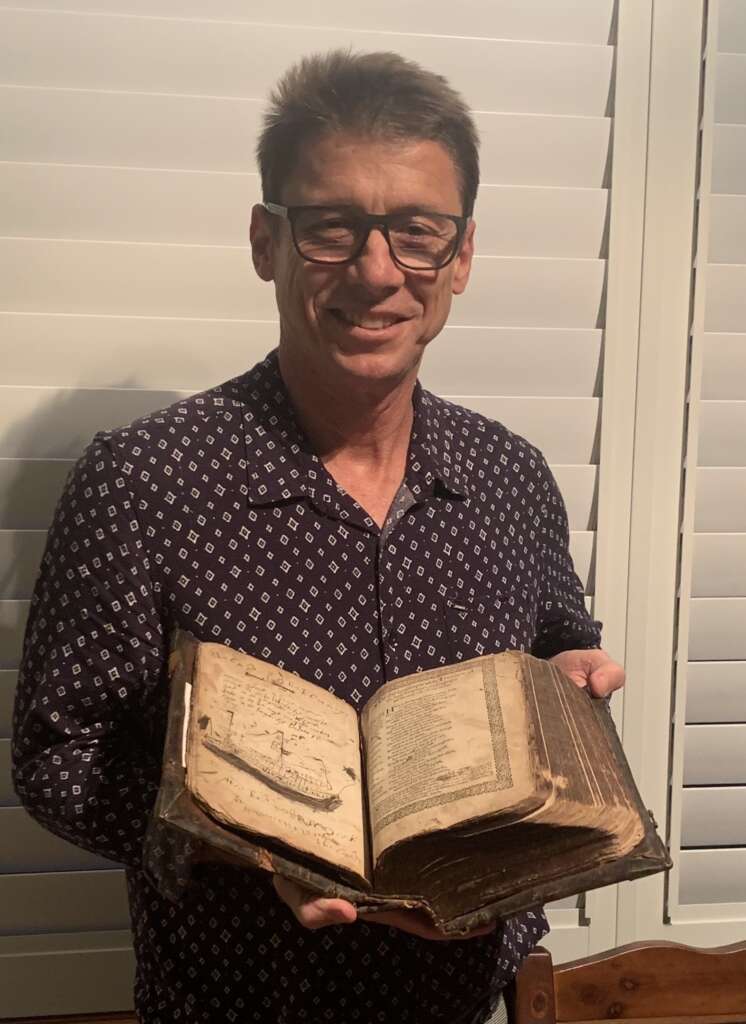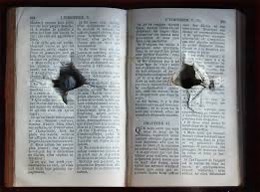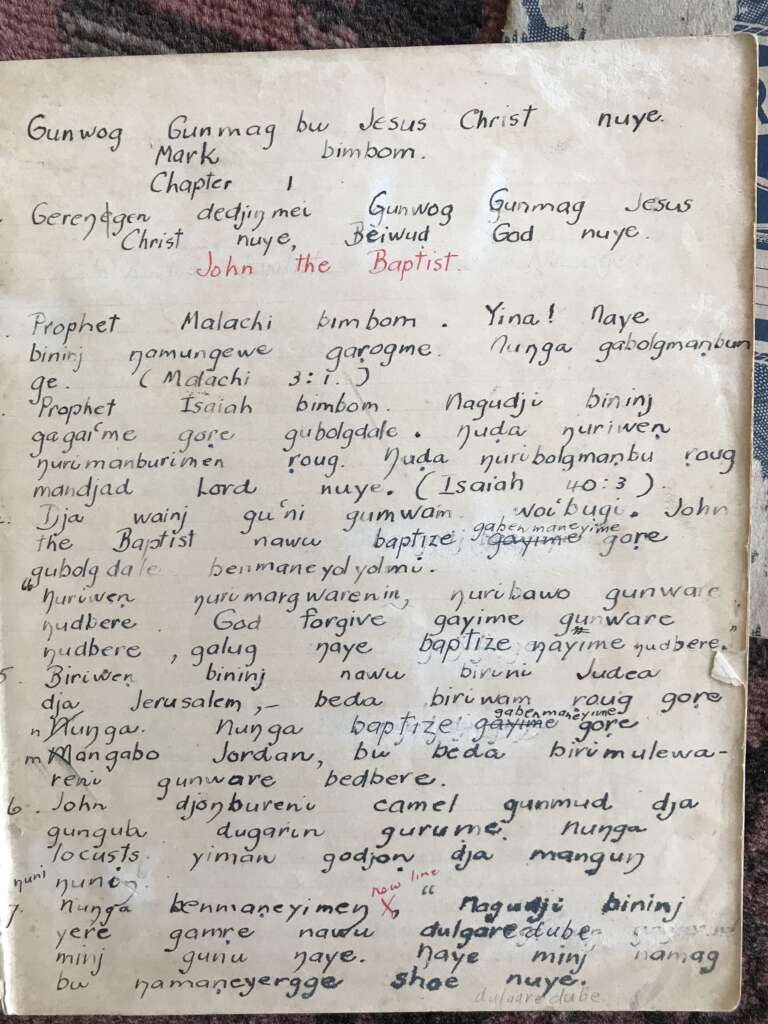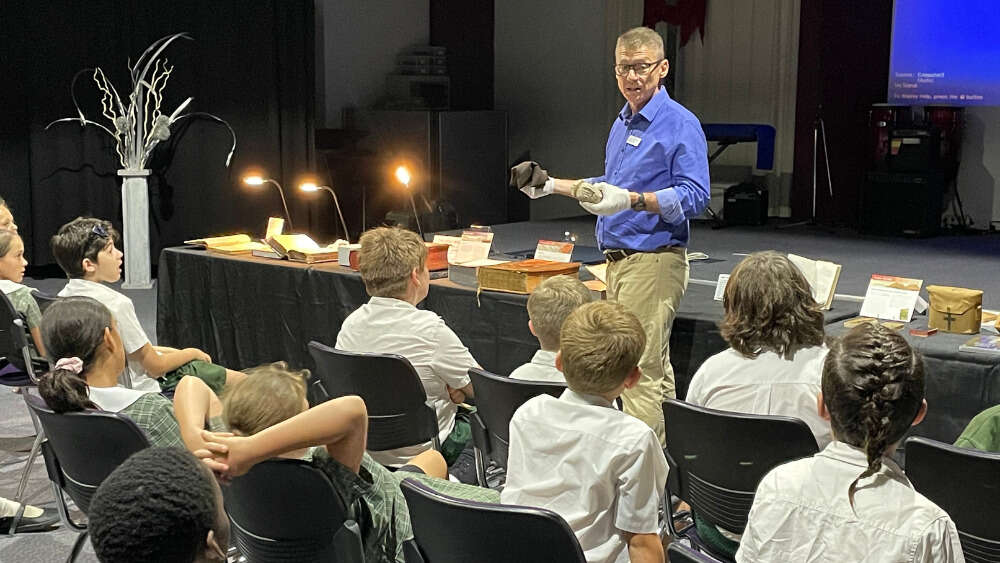Bible tour highlights blood and sacrifice
Helping young people pass on the value in God’s word to the next generation.
Primary school children were enthralled by a display of historic Bibles and artefacts at Liberty College in Tamworth and the stories of sacrifice behind them, says Jonathan Harris, Donor Care Representative for Bible Society Australia (BSA).
Harris, whose grandmother Nell Harris, spent 36 years in Arnhem Land translating the Kunwinjku Bible, said this was the most fulfilling experience of a recent three-day Bible Roadshow he did in northern NSW as part of fundraising for BSA.
“We hadn’t advertised for schools, but the College we presented in made a special request to bring their students in,” he says.
“It was wonderful to see Indigenous kids hear the stories of Aboriginal Bible translations.”

Jonathan Harris with the Geneva Bible 1609
The display included the first handwritten translation of the Gospel of Mark in the Aboriginal language Kunwinjku, from 1939, completed by Nell Harris, and the Shorter Bible from 80 years later, which Harris took back to Gunbalanya in 2018.
Harris is passionate about creating a legacy that will help young people see the value in God’s word and pass that on to the next generation.
So it warmed his heart to see a young man see the display, then walk out to phone a friend to come and join him. “He then went through the whole collection explaining the significance of all the Bibles to his friend from memory!”
The Bibles come from a collection of more than 8000 Bibles and artefacts in the BSA library, the oldest in Australia, which is housed at St Mark’s Theological Centre in Canberra, many of which require careful handling.
“The challenge is they’re very fragile books and every time we get them out, I have to hold them with the white gloves. So packaging and repackaging the displays I have to be very careful and it makes me nervous travelling in the car, especially, but I’ve got waterproof and dustproof hard cases now to try and carry them around with,” he explains.
Earlier this month, Harris invited some friends to a private viewing and potluck meal at his home in Newcastle, north of Sydney.
One friend was so delighted by how impressed his two children were to see the historic Bibles that he wrote to Harris the next day, saying they had not only spoken about the highlights the next morning, but they had actually read their own Bibles! “I think they finally realised how important and valuable it is …We need kids to understand the value of God’s word,” the friend said.
“Bible literacy to me is the real struggle that’s happening now.” – Jonathan Harris
Harris now hopes to take the display of Bibles into schools so that children are reminded of the importance of the Scriptures.
“We’re starting to see that people are really valuing the written word, not just the digital form because a lot of kids in my daughter’s youth group – and I’ve heard this everywhere – want spirituality, but they don’t really want in-depth theology or the Bible. There’s a therapeutic, moralistic kind of faith rather than real Bible literacy, so Bible literacy to me is the real struggle that’s happening now.”
A young reporter from the Northern Daily Leader who attended the Tamworth Roadshow had no idea of the stories of sacrifice behind some of the historic Bibles. She later entitled her story “Ancient Bible Collection shares stories of risk and revolution”!
 The collection includes a Tyndale New Testament from 1551, one of the editions that followed William Tyndale’s martyrdom. Tyndale translated and printed the New Testament into the English language which was illegal in his day, before being strangled and burnt at the stake in 1536 for this “heresy”.
The collection includes a Tyndale New Testament from 1551, one of the editions that followed William Tyndale’s martyrdom. Tyndale translated and printed the New Testament into the English language which was illegal in his day, before being strangled and burnt at the stake in 1536 for this “heresy”.
Other significant items include the famous Bullet in the Bible, from Gallipoli – the shrapnel and Bible are in their original condition after a soldier was protected by carrying the Scriptures in his front pocket; the Gogodala PNG Mark’s Gospel for which missionaries were martyred to get the translation to the people during World War II; and the Delaney communion kit from Vietnam, still containing communion wafers and wine given to combat soldiers.
The road trip also highlighted one of Governor Macquarie’s Russian Bibles and included his signature and dated 1821.
“There were tears at the end of the story in the audience as we looked back on 500 years of sacrifice.” – Jonathan Harris
Other treasures were a first-edition King James Bible 1611, and Governor Hunter’s Bible 1773, which arrived on the First Fleet. It enclosed secret orders about the management of the new colony and had an engraved leather cover made by a convict he sailed out with.

The first handwritten copy of Nell Harris and Rachel Maralngurra and Hannah Mangiru’s Kunwinjku Gospel of Mark from 1939
“I finished with my grandmother’s Kunwinjku New Testament and the story of her wanting to get the gospel into the hearts of the people of Arnhem Land,” he says.
“There were tears at the end of the story in the audience as we looked back on 500 years of sacrifice that many had made to get the Scriptures to us today – not just a book but the word of God.”
Jonathan Harris is not related to BSA’s world-renowned historian John Harris, who told these stories during a national Bible roadshow 12 years ago, mounted to celebrate the 400th anniversary of the King James Bible.
But they share a Bible history. John’s father, Len Harris, did Indigenous Bible translation at Roper River, now called Ngukurr, at the same time that Jonathan’s grandmother, Nell Harris, was working on the Kunwinjku Bible at Oenpelli (now Gunbalanya).
Jonathan grew up in Gunbalanya while his father, Wilfred Harris, following in the footsteps of his parents Dick and Nell Harris, worked on the mission there. When he took the newly published Kunwinjku Shorter Bible there in 2018, he met descendants of the original translators, Rachel Maranlngurra and Hannah Mangiru, who adopted him into their Narbolanj Skin clan.
“It was absolutely humbling. Would we do that with Aboriginal people if they came to our church?” he wonders.
Email This Story
Why not send this to a friend?


